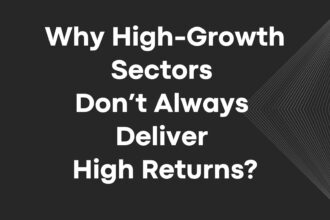Written By: Nishant Parsad
The obvious prospect of physical growth in a business does not translate into obvious profits for investors.
– Benjamin Graham
The excitement around high-growth industries is contagious. Whether it’s Electric Vehicles (EVs), Quick Commerce, Renewable Energy, or Defence, investors are often drawn in by the promise of rapid expansion. The logic seems simple: if an industry is booming, investors should benefit.
But history tells a different story. Many industries that have witnessed phenomenal growth have failed to generate sustainable profits for investors. Why? Because growth alone isn’t enough.
A Classic Illusion: The More, the Merrier?
Picture this: A new restaurant opens in your neighborhood, serving the most exquisite dishes at unbeatable prices. People flock to it. Encouraged by its success, five more restaurants open up on the same street. Suddenly, the once-booming eatery struggles with razor-thin margins, price wars, and customer fragmentation.
This is exactly what happens in high-growth industries. Growth attracts competition, and without a strong moat, businesses get caught in a race to the bottom.
Let’s break down why not all growth stories make great investments.
1. The “Race to the Bottom” in High-Growth Sectors
The moment an industry starts showing rapid expansion, competitors rush in. More players mean price wars, margin pressure, and an eventual battle for survival.
Example: The Quick Commerce Battle
Just a few years ago, Quick Commerce (QComm) was an uncertain bet. Investors weren’t sure if 10-minute grocery delivery could even be profitable.
Then, Blinkit (Zomato’s QComm arm) cracked the code—it grew rapidly while showing early signs of profitability. Suddenly, everyone wanted a piece of the pie:
– BigBasket, Flipkart, and Amazon jumped in.
– Zepto and Swiggy Instamart raised huge rounds to expand aggressively.
The result? Blinkit’s early success is now its biggest threat. What was once a high-margin business is now a price war, forcing all players to burn cash to survive.
E-commerce in 2010-2020 saw the same fate. Flipkart, Amazon, Snapdeal, and Paytm Mall burnt billions acquiring customers, but only Flipkart and Amazon survived—and neither is profitable yet.
Key Lesson: Being in a high-growth industry isn’t enough. If a company doesn’t have a strong competitive advantage, it will struggle when the market gets crowded.
2. The Unpredictable Battle: Who Will Be the Winner?
Even if a sector eventually has winners, predicting them early is nearly impossible.
Take food delivery in India (2014-2020):
– FoodPanda and TinyOwl were seen as leaders.
– Swiggy entered aggressively.
– Zomato was late to the game and initially didn’t believe in running its own delivery fleet.
Fast forward to today—FoodPanda, TinyOwl, Uber Eats, and Ola Café are all gone. Meanwhile, Zomato, which started late, is now leading the pack.
This happens in every high-growth sector. The company that looks like the “winner” today may not even exist tomorrow.
Key Lesson: Even if an industry is growing, picking the right stock within that industry is a gamble.
3. The Capex Binge: Why Too Much Expansion Can Backfire
When companies see booming demand, they often expand aggressively, assuming the growth will last forever. But what happens when demand slows down? Overcapacity leads to value destruction.
Case Study: India’s Power Sector Boom & Bust
– In the early 2000s, government incentives triggered massive investment in power plants.
– Developers overbuilt capacity, expecting demand to keep rising.
– Reality check: Demand growth slowed, and many power plants didn’t have fuel linkages or purchase agreements.
– The result? Massive debt, bankruptcies, and stocks crashing 90%+.
A similar bubble may be forming in EVs, Solar, and Defence. Today, companies are expanding aggressively, but if demand doesn’t keep pace, many will struggle with excess capacity and falling prices.
Key Lesson: Growth must be sustainable. Companies that over-expand too quickly can end up destroying value instead of creating it.
4. The Valuation Trap: When Hype Outruns Reality
High-growth stocks often trade at 100-150x P/E. Why? Because investors price in future expectations rather than actual profits.
Examples of Hype-Fueled Crashes:
– Dot-com Bubble (1999-2000): Tech stocks soared before anyone made money. The crash wiped out trillions.
– Indian E-commerce (2010-2020): Companies raised billions, but profits never came. Investors who entered late lost big.
Today, Solar, Defence, Quick Commerce, and EMS are repeating history. Stocks in these sectors are priced for perfection, meaning even a slight slowdown could trigger massive corrections.
Key Lesson: If a stock is priced too high, even strong business growth won’t guarantee returns.
So, How Should Investors Approach High-Growth Sectors?
1. Look for Strong Moats: Only invest in companies that can defend their market share—through strong brands, scale, patents, or unique technology.
2. Avoid Overpaying: If a stock is trading at 100x earnings, be careful—it may take years of perfect execution for it to justify that price.
3. Watch for Capex Madness: Avoid companies blindly expanding without clear long-term demand.
4. Be Skeptical of Market Hype: If everyone is chasing a sector, the best gains have already happened.
5. Diversify: Instead of betting on one company, spread your risk across multiple sectors.
Final Thoughts: Growth Alone Won’t Make You Rich
Investing in high-growth sectors feels exciting, but it comes with hidden traps:
– Competition destroys margins.
– Predicting long-term winners is extremely hard.
– Over-expansion leads to value destruction.
– Overhyped valuations often end in crashes.
The best investors don’t just chase growth. They look for sustainable advantages, reasonable valuations, and real profitability.
At the end of the day, FOMO investing leads to regret. Patience and fundamentals win in the long run.






